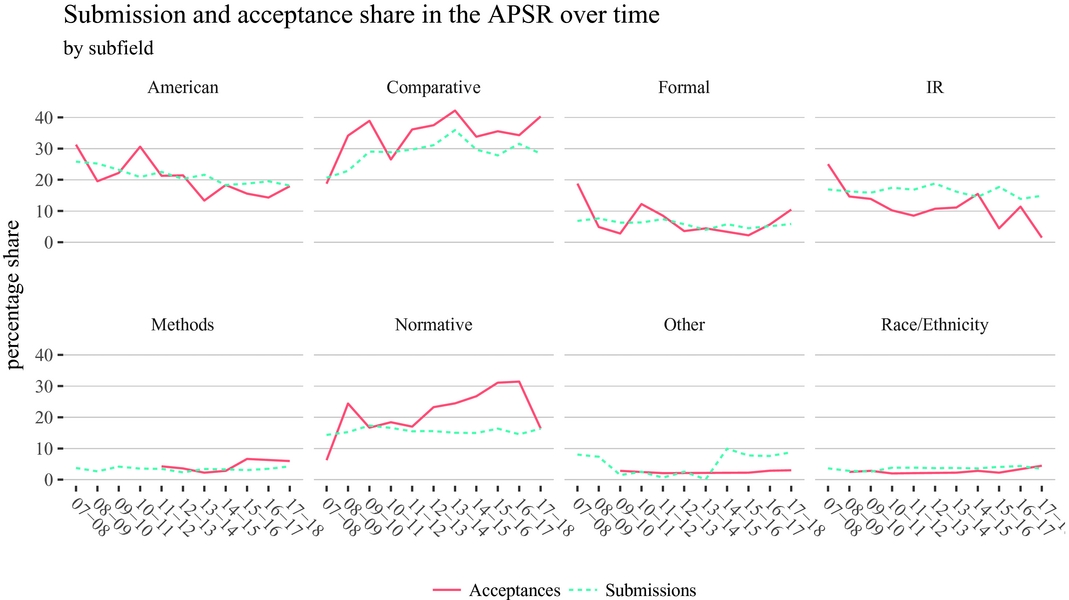Like other sciences, Political Science consists of subfields with, at times, different focuses, methodological approaches, and understandings of what constitutes “scholarly research of exceptional merit” that is worth being published in the American Political Science Review (APSR). In these Notes from the Editors, we want to take a closer look at subfield developments over time and provide some insights into the role of subfield classification in our editorial process. Being a cornerstone of this journal, we work hard as editors to publish a balanced selection of research from these subfields, which should theoretically mirror the submission rates we receive. Yet, despite having their own standards and principles for the evaluation of excellent manuscripts, subfield classifications often overlap in practice and change over time. Before we go into detail, we would therefore like to stress that the comparison of subfield developments, such as the number of submissions and acceptances, should always be taken with a grain of salt as their classification is neither exclusive nor complete.
As a generalist journal, we pursue a pluralist strategy that covers all subfields in Political Science. However, not unlike any other scholar, editors and reviewers tend to apply their own subfield standards and principles when it comes at evaluating other research. When we took over the editorship we were aware of such potential subfield bias which, in the worst case, may result in systematic subfield differences. In order to reduce such bias and cope with the approximate 1,400 manuscripts we receive annually, we introduced a bilateral editorial decision-making system that combines the subfield expertise of our associate editors with an increased level of accountability and oversight being the responsibility of the lead editor. While the former is targeted at being able to identify merit in a subfield, the latter aims at ensuring an overall balance in the journal's orientation to cover research from subfields throughout the discipline.
With the responsible associate editors still having discretion left in their decision making, the assignment of manuscripts to subfields may become influential for the review process of a manuscript. Usually, authors indicate the subfield(s) to which their manuscript belongs, which in turn sends the first signal regarding the selection of both the responsible associate editor and potential reviewers. Nevertheless, the lead editor may disagree with the authors’ subfield assignment and allocate the manuscript to an associate editor from another subfield who is likely to have expertise on different aspects of the manuscript's subject. Consequently, this associate editor may select different reviewers than who the authors originally may have had in mind. While the overall review of the manuscript could come from a different (subfield) perspective than what maybe was expected from the original subfield classification, ultimately, this should not matter as the research published in the APSR should speak to the whole discipline, rather than a particular subfield only.
As editors of the APSR, it is our responsibility to select the appropriate reviewers for manuscripts that are sent out for review. Even though most manuscripts are eventually rejected, potentially the most important service we provide our authors with is our dedication to receiving quality reviews that ultimately improve the authors’ research independent of the editorial outcome. In fact, it might be commonly believed that the bulk of editors’ work concentrates on the selection of publishable manuscripts, but we have come to understand that a similarly challenging task is to satisfy the disappointed authors of rejected manuscripts. These manuscripts constitute around 95% of our submissions and their authors, as a result make up a large part of our reviewer pool. Without their expertise and support, a reviewer pool of only authors whose manuscripts were published would be empty very quickly. We believe that by providing excellent reviews we can succeed in overcoming their disappointment and help them improve their research and publication chances in the future.
In the figure below we present a closer look at how both submission and acceptance rates across subfields have developed over the last decade. As mentioned before, subfields are reported by the authors when submitting to the APSR. The shares of submissions and acceptances are calculated per editorial term, which runs from July 1st to June 30th the following year.
A few developments are worth discussing. For most subfields, submission and acceptance rates correlate with each other on average. It suggests that most of the time, the editors were and are able to make acceptance decisions that reflect the composition of subfield submissions they receive. This is true for the major subfields American Politics, Comparative Politics and International Relations, but is also true for the smaller subfields we also review.
Nevertheless, there are also periods were submission and acceptance rates deviate more persistently. For example, acceptance rates in Normative Political Theory were much higher than the submissions rates before we took over. In the current editorial term, however, this ratio is much more balanced. Yet, we also see diverging developments during our term: While the share of accepted manuscripts in both Comparative Politics and Formal Theory has been increasing in comparison to their submission share, we observe a decline in acceptances in International Relations, which follows a trend from previous years.
One potential explanation for the diverging trends in Comparative Politics and International Relations is that, at least from our impression, the borders of these two subfields are increasingly blurred. For example, we receive an ever-increasing number of field experiments, which were conducted in Africa and Asia, with subfield classifications to either Comparative Politics or International Relations. We will continue to follow the development of subfield composition closely as we continue to try our best to detect and publish original and well-crafted research from all subfields. As always, we are open for constructive suggestions that may help us in this endeavor.

INSTRUCTIONS TO CONTRIBUTORS
Our submission guidelines can be found at the APSA website at: http://www.apsanet.org/APSRSubmission-Guidelines.
Do not hesitate, in any cases of doubt, to consult the APSR Editorial Offices with more specific questions by sending an e-mail to: apsr@mail.uni-mannheim.de.




